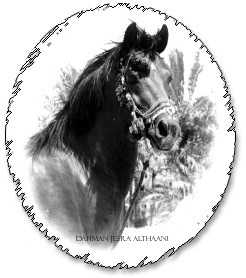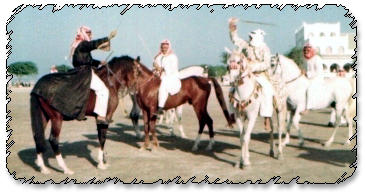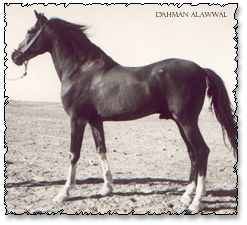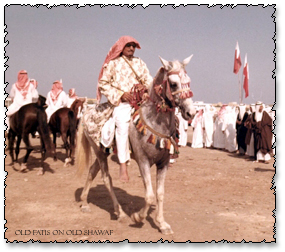Under the strong and wise Al-Khalifa
rulers, Bahrain
prospered and grew to be the centre for the pearl diving
industry. Situated near the coast of Arabia proper, yet isolated from
it as a group of islands, it often became a sanctuary for tribal Shaikhs
a nd their mares at times of warfare on the mainland. According to old
tribal system, all horses belonged to the ruling Shaikh, who
traditionally kept a sizeable stud. This is a custom, which has been
kept up until present day. nd their mares at times of warfare on the mainland. According to old
tribal system, all horses belonged to the ruling Shaikh, who
traditionally kept a sizeable stud. This is a custom, which has been
kept up until present day.
It would be impossible to state the exact year
when certain strains of horses first appeared with the
Al-Khalifa.
Some strains have been with the family for as far back as history
is known, while others were acquired later by certain rulers as is
well remembered or documented. Battle lore in Bahrain is rich in
describing the Al-Khalifa horses-many mares became famous in
these battles for their fire and stamina.
The last battle on
horseback to be fought on Bahrain soil took place in 1869 when Mohammed
bin Khalifa invaded the island with his army from the mainland, and was
met at Rufa hill by his half-brother Ali and his horsemen. In the
ensuing battle many brave horses and men were killed including Shaikh
Ali. The last horses to leave Bahrain for war purposes left in 1928,
when a group of horses, among them three mares; Dahmeh,
Jellabieh and Obeyah were sent on
request to Fahad bin Abdulla Al-Jiluwi, the son of Emir of Al-Hasa
province. Fahad fought a campaign against the Ajman tribe and was slain
in a battle full of treachery and intrigue. History does not relate what
became of these three Bahrain fighting mares.
With the advent of the motor car and peaceful life in general, the
Bahrain war mare could have gradually disappeared, but the family
tradition of horses was very strong and pride in her ensured that
she survive. Her nimbleness of foot was tested in pageants and mock
battles, and her stamina was proven in long distance informal races.

In the past, some
individual mares of certain strains became famous for their courage,
speed and stamina on the battlefield. Consequently they were much
coveted and appreciated if presented as a gift. Through the inherent
generosity of the Arab people, many of these mares exchanged hands
frequently. As a matter of honour each Shaikh would give of his best
and only good mares were thus exchanged. Today, the descendants of some
of the famous mares are still treasured more than others from less
renowned strains.
Some stallions also
attained more prominence than others by their exhibitional behaviour,
carriage, spirit and soundness, particularly when chosen by an important
Shaikh as his personal mount. They were much sought after as studs,
while other stallions equally good yet less legendary would soon fade
from memory.
Selection of stud
stallions is done by bloodline, performance and conformation. Once a
stallion is tested on a few mares and the progeny are up to standard, he
will stand at stud for the rest of his life. No stallion is tried before
full maturity, at the age of 7 years or more. Relatively few stallions
are allowed to breed and the excess stallions are used for racing, gifts
and police mounts.
No outside stallion
is directly used for stud purposes. New blood was introduced indirectly
by the high caste mares received or exchanged with other Shaikhs from
the interior of Arabia. When these mares were bred to local stallions,
their progeny or grand-progeny sometimes qualified as studs
The different
strains or families of Arab horses are perpetuated through the mares,
offspring always taking the dam’s name regardless of the stallion’s
strain. Although all the strains found in Bahrain are equally pure,
stud horses are chosen only from the strains deemed most noble. The
word ‘noble’ here is the nearest equivalent to the Arab word ‘asil’ and
does not convey the exact meaning. All tribes recognise the inherent
nobility of certain strains but the preference for some strains over
others varied from tribe to tribe.
It w as the custom in Central Arabia for the prominent Shaikhs
to keep stud horses from a few
selected
strains only, but in some tribes after repeated breeding
of these stallions with mares of a ‘new’ strain, the progeny of the
latter gradually gained acceptance as studs. In general, once
a stallion has been chosen to stand as stud, his strain becomes
unimportant. The fact the he is chosen is the guarantee of his
nobility. as the custom in Central Arabia for the prominent Shaikhs
to keep stud horses from a few
selected
strains only, but in some tribes after repeated breeding
of these stallions with mares of a ‘new’ strain, the progeny of the
latter gradually gained acceptance as studs. In general, once
a stallion has been chosen to stand as stud, his strain becomes
unimportant. The fact the he is chosen is the guarantee of his
nobility.
In Bahrain a new generation’s tribal Shaikh
would often favour a different strain to his predecessor and would
increase horses of his favourite family line. However, the ancient
revered lines maintained their supremacy in the long run, although
unfortunately one or two of them have disappeared.
Next >> |

